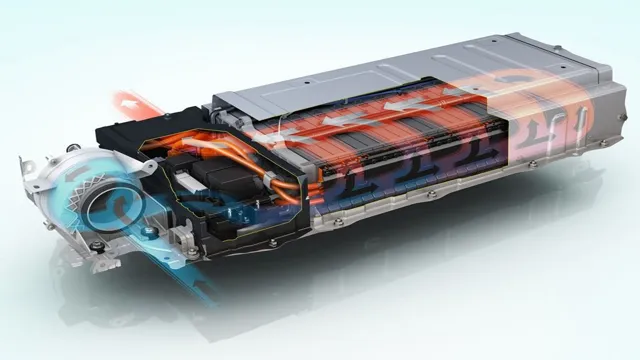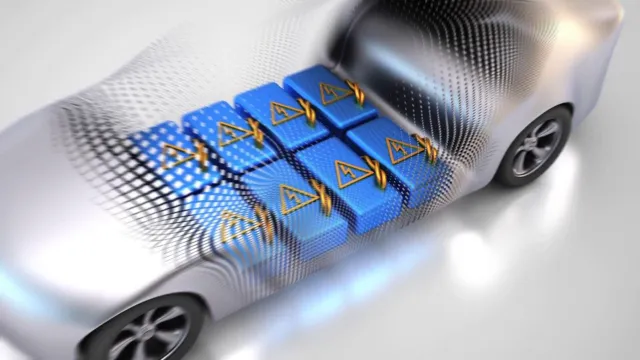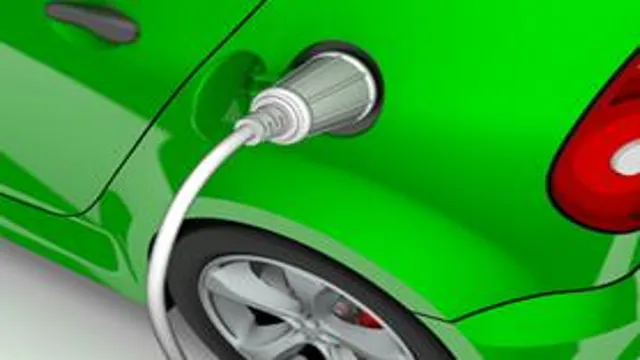Electric Car Battery Cooling – Keep Your Battery Cool and Your Car Going!
Electric cars are becoming more and more popular, and for a good reason. They are eco-friendly, quiet, and cost-effective in the long run. However, one major challenge that manufacturers face is how to properly cool the electric batteries.
Without proper cooling, the battery lifespan can be significantly reduced, leading to reduced performance and efficiency. In this blog post, we will explore the benefits of cooling electric car batteries, the different cooling methods available, and how it affects the overall performance of your electric vehicle. So buckle up and get ready to learn how keeping your electric car battery cool can help you get the most out of your vehicle!
Why Battery Cooling is Critical
Electric car battery cooling systems are critical to ensure the longevity and performance of the batteries. When lithium-ion batteries get too hot, they begin to degrade rapidly, leading to reduced range and capacity. The heat generated during charging and discharging creates heat that must be dissipated for optimal driving.
Electric car battery cooling systems use liquid or air to draw heat away from the battery and dissipate it. A liquid cooling system uses a series of pipes and pumps to circulate coolant around the battery pack, while an air-cooled system uses fans and ducts to blow air over the battery cells. Without proper cooling, electric cars would be prone to overheating and other problems that could critically affect their safety and reliability.
Electric car manufacturers must design and implement effective battery cooling systems to ensure that their cars can perform at their best and last for years to come.
Preventing Battery Overheating
Battery cooling is critical in preventing battery overheating. Overheating can shorten the battery’s lifespan and even pose a safety risk. When a battery is in use, the energy storage and conversion processes generate heat.
If the heat cannot dissipate properly, it can cause internal damage to the battery, reducing its capacity and potentially damaging other components. In extreme cases, it can even cause fires or explosions. This is why battery cooling systems are essential in many applications.
They help regulate the temperature of the battery, ensuring that it doesn’t get too hot. There are several ways to cool a battery, including liquid cooling, air cooling, and thermoelectric cooling. The type of cooling used depends on the application and the battery’s size and capacity.
Proper battery cooling not only helps extend the battery’s lifespan but also ensures safer operation, making it a critical consideration for any application that utilizes batteries.

Improved Performance & Longer Battery Life
When it comes to high-performance devices like laptops and gaming machines, battery cooling is critical for both improved performance and longer battery life. Without proper cooling, the batteries can overheat, leading to decreased battery life and even damage to the device itself. This is especially true for power-hungry components like CPU and GPU, which can generate a lot of heat when running at full throttle.
But why is battery cooling so important? Well, when batteries get too hot, their chemical reactions can become unstable, leading to reduced performance and efficiency. Additionally, high temperatures can cause irreversible damage to the battery, shortening its lifespan and reducing its capacity over time. By implementing effective cooling solutions like heat sinks, fans, and thermal paste, device manufacturers can ensure that their products operate at peak performance while also prolonging the life of their batteries.
So, if you’re someone who relies on their laptop or gaming machine for work or play, it’s worth investing in a device with robust battery cooling to maximize both its performance and longevity.
Types of Cooling Systems
Electric car battery cooling systems are critical components that help regulate the temperature of the battery. There are primarily two types of cooling systems: liquid and air-cooled. Liquid cooling systems depend on a network of pumps and pipes to circulate coolant around the battery pack.
The liquid absorbs heat from the battery and transfers it to a heat exchanger, where it is dissipated through air or water. On the other hand, air-cooled systems utilize fans and vents to draw hot air away from the battery and cool it down. This system is simpler and lighter, but it may not be suitable for high-powered electric vehicles, especially under demanding driving conditions.
In addition to these basic types, there are hybrid cooling systems that combine air and liquid cooling to provide optimal temperature management. By maintaining stable battery temperatures, these cooling systems can help prolong battery life, improve power delivery and ensure safety during operation.
Active vs Passive Cooling
When it comes to cooling systems, there are generally two types to choose from- active and passive cooling. Active cooling systems use external power to cool, while passive cooling systems rely on natural methods to dissipate heat. Active cooling systems are usually more effective in cooling large areas or electronic devices with high power consumption, while passive cooling systems work best for smaller devices.
One example of an active cooling system is an air conditioner, which uses electricity to lower the temperature of a room. Passive cooling systems, on the other hand, use natural methods such as ventilation or heat sinks to cool down devices without the need for additional power. One example of passive cooling is the use of shades, awnings, or cross ventilation to cool a room naturally.
Ultimately, the choice between active and passive cooling depends on the situation, with active cooling being better suited for larger cooling needs and passive cooling for smaller ones. By considering your needs and the size of the space or device, you can choose the best type of cooling system for your requirements.
Liquid vs Air Cooling
When it comes to cooling your PC, there are two main options: liquid and air cooling. Air cooling is the more traditional method, utilizing fans to pull cool air into the PC case and push hot air out. While this method is generally reliable, it can be loud and may not be sufficient for high-end builds.
On the other hand, liquid cooling uses a pump to circulate liquid through a series of tubes or pipes, effectively absorbing heat from the components before being cooled through a radiator and re-circulated. This method is typically more expensive and requires a bit more maintenance, but it is generally quieter and more efficient than its air cooling counterpart. Ultimately, the choice between liquid and air cooling comes down to personal preference and the specific needs of your build – do you need a more silent operation or higher cooling capacity? It’s up to you to decide which method to choose, but no matter which route you go, ensuring proper cooling is essential to keeping your PC running smoothly and preventing damage to your components.
Comparison of Popular Cooling Systems
When it comes to cooling systems, there are several different types to choose from. The most common ones include air conditioning units, evaporative coolers, and refrigeration systems. Air conditioning units work by removing heat and moisture from the air, while evaporative coolers use water to cool the air.
Refrigeration systems, on the other hand, work by removing heat from one location and transferring it to another. Each of these systems has its own strengths and weaknesses, making it important to choose the one that best fits your needs and budget. For example, air conditioning units are great for humid climates but may be expensive to operate, while evaporative coolers are inexpensive to operate but may not be effective in areas with high humidity.
Ultimately, the key to selecting the right cooling system is to consider your unique situation and consult with a professional to ensure you make the best choice for your needs.
Pros & Cons of Battery Cooling Systems
When it comes to electric car battery cooling systems, there are both pros and cons to consider. One benefit of having a cooling system for the battery is that it can help extend its lifespan. When the battery is exposed to extreme temperatures, it can degrade more quickly, leading to a shorter overall lifespan.
However, a cooling system can help regulate the temperature and prevent this from happening. On the other hand, battery cooling systems can add additional weight to the car, which can affect its overall efficiency and range. Additionally, more complex cooling systems can be expensive to maintain and repair if they break down.
Overall, it is important to weigh the potential benefits and drawbacks of battery cooling systems when considering an electric vehicle.
Advantages of Effective Cooling
Battery cooling systems can offer numerous benefits, but also come with a few drawbacks. One major advantage of an effective cooling solution is that it can greatly extend the lifespan of a battery. High temperatures can cause damage to the internal components of a battery, leading to deterioration over time.
By implementing a proper cooling method, the battery can operate at a lower, more stable temperature, which in turn prevents damage and prolongs its life. Additionally, a cooler battery can also maintain its charging capacity for longer periods of time, ensuring that it is always ready for use when needed. However, there are also potential downsides to consider.
Some cooling systems can be bulky, adding weight and reducing portability. They may also require an additional power source, which can place additional strain on the battery and impact overall performance. Careful consideration should be taken when selecting a cooling system, with factors such as size, efficiency, and power requirements being taken into account.
Overall, a well-designed cooling solution can unlock the full potential of a battery, providing extended life and improved performance.
Disadvantages of Ineffective Cooling
When it comes to battery cooling systems, there are both advantages and disadvantages to consider. On one hand, effective cooling can prolong the life of the battery and improve performance. With proper cooling, the risk of overheating and thermal runaway is reduced, which can be a safety hazard.
However, there are also some drawbacks to battery cooling systems. Ineffective cooling can lead to a decrease in battery life, reduced efficiency, and even damage to the battery. This is because high temperatures can cause chemical reactions within the battery that lead to degradation and loss of capacity.
In extreme cases, a poorly cooled battery can even catch fire or explode. So, while cooling is an important aspect of battery technology, it’s essential to choose a cooling system that is effective and reliable.
Future of Battery Cooling Technology
As electric cars become more popular, it’s clear that electric car battery cooling systems will play a significant role in the industry’s future. The current state of battery cooling technology is already pretty advanced, but it’s not perfect. One of the main challenges is the issue of heat distribution – because batteries generate a lot of heat, they need to be cooled in order to avoid things like overheating and electrical fires.
As a result, battery cooling systems have to work hard to keep the batteries at a consistent temperature. However, new innovations in the field are making it possible to develop even more efficient and effective cooling systems. For example, some companies are working on systems that distribute coolant across the battery pack in a more even and controlled way.
Others are experimenting with new materials that can absorb and store heat, which can later be released to keep the batteries at a consistent temperature. While there is still work to be done, it’s clear that the future of electric car battery cooling systems is bright and full of potential.
Conclusion
In conclusion, electric car battery cooling systems are a crucial component in ensuring the longevity and performance of electric vehicles. Without proper cooling, batteries can become damaged or even overheat, putting both the driver and the car at risk. Just like a refreshing summer breeze on a hot day, these cooling systems keep things cool and smooth on the road.
So let’s keep our batteries cool and our electric cars cruising!
FAQs
What is an electric car battery cooling system?
An electric car battery cooling system is a system designed to regulate the temperature of the battery pack in an electric vehicle to prevent overheating and extend the battery’s life.
How does an electric car battery cooling system work?
An electric car battery cooling system typically uses liquid or air cooling to regulate the battery’s temperature. The cooling system circulates the coolant or air through the battery pack to maintain the optimal temperature range.
Why is a battery cooling system important in electric cars?
A battery cooling system is important in electric cars because high temperatures can cause the battery to degrade faster, reducing its capacity and overall lifespan. By regulating the battery’s temperature, the cooling system can help extend the battery’s life and improve performance.
What are some common types of electric car battery cooling systems?
There are two common types of electric car battery cooling systems: liquid cooling and air cooling. Liquid cooling uses a glycol-based coolant to regulate the battery’s temperature, while air cooling uses fans or other methods to circulate air through the battery pack. Some electric vehicles may also use a combination of both cooling methods.






